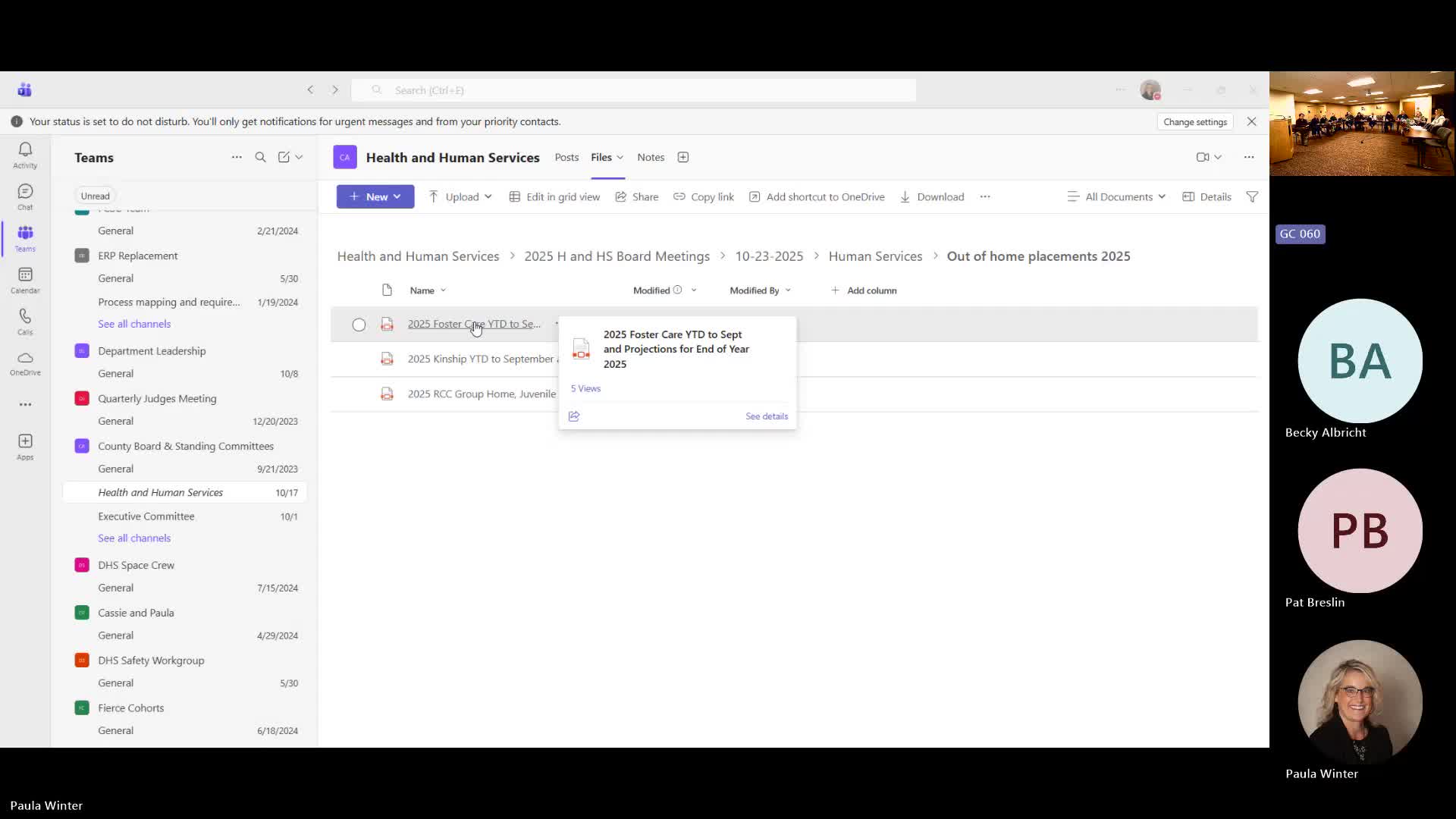Dunn County: rising residential placement costs strain human services budget; supervisors push for state-level solution
October 27, 2025 | Dunn County, Wisconsin
This article was created by AI summarizing key points discussed. AI makes mistakes, so for full details and context, please refer to the video of the full meeting. Please report any errors so we can fix them. Report an error »

Dunn County Health and Human Services staff told the county board on Oct. 23 that the number of children in out-of-home care has fallen in recent years but per-child costs have risen sharply because of increased clinical and one-to-one care needs.
Director Paula Winter said the county currently has 27 children in foster care, six in treatment foster care and 17 in subsidized guardianship, while higher-cost settings such as group homes and residential care centers account for a disproportionate share of expenses. Winter presented a chart showing total foster-care-related costs rose even as caseloads declined: ‘‘When we had 48 kids in care in 2020, it was $288,000. With 27 kids, it’s $313,000,’’ she said, describing how administrative and specialized-placement fees drive the change.
Why it matters: County officials said these ‘‘stochastic’’ high-cost placements — a single youth in a secure or residential setting can add hundreds of thousands of dollars to annual costs — can blow a county budget and are difficult for a single county to absorb. Supervisor Dr. Bridal and others urged the county to press state lawmakers to change the funding structure so costs are pooled or reimbursed at the state level.
Board discussion focused on options for legislative advocacy and fiscal mitigation. Supervisors recommended that the legislative agenda include a clear, specific request that the state assume or share responsibility for the highest-cost placements rather than leaving the full financial risk with individual counties. Chair and staff noted the ledger implications: county reserves and unpredictable placements create planning difficulty for human services budgets.
Staff provided more detail about placement types and per-placement figures: treatment foster-care administrative fees can match foster-home payments, residential care centers carry six-figure price tags, and secure juvenile detention placements have daily per-person costs that contributed to large annual totals. Winter said kinship care remains the preferred, least-cost option where safe and appropriate, and that the county receives some state reimbursement for subsidized guardianship but not for many other placement costs.
Next steps: The board asked staff to include a concise, itemized legislative ask about state-level sharing of high-cost placement risk when the county’s legislative agenda is redrafted. The committee indicated it wants ready-to-share, single-issue language and concrete dollar or policy examples for one-on-one meetings with legislators.
Director Paula Winter said the county currently has 27 children in foster care, six in treatment foster care and 17 in subsidized guardianship, while higher-cost settings such as group homes and residential care centers account for a disproportionate share of expenses. Winter presented a chart showing total foster-care-related costs rose even as caseloads declined: ‘‘When we had 48 kids in care in 2020, it was $288,000. With 27 kids, it’s $313,000,’’ she said, describing how administrative and specialized-placement fees drive the change.
Why it matters: County officials said these ‘‘stochastic’’ high-cost placements — a single youth in a secure or residential setting can add hundreds of thousands of dollars to annual costs — can blow a county budget and are difficult for a single county to absorb. Supervisor Dr. Bridal and others urged the county to press state lawmakers to change the funding structure so costs are pooled or reimbursed at the state level.
Board discussion focused on options for legislative advocacy and fiscal mitigation. Supervisors recommended that the legislative agenda include a clear, specific request that the state assume or share responsibility for the highest-cost placements rather than leaving the full financial risk with individual counties. Chair and staff noted the ledger implications: county reserves and unpredictable placements create planning difficulty for human services budgets.
Staff provided more detail about placement types and per-placement figures: treatment foster-care administrative fees can match foster-home payments, residential care centers carry six-figure price tags, and secure juvenile detention placements have daily per-person costs that contributed to large annual totals. Winter said kinship care remains the preferred, least-cost option where safe and appropriate, and that the county receives some state reimbursement for subsidized guardianship but not for many other placement costs.
Next steps: The board asked staff to include a concise, itemized legislative ask about state-level sharing of high-cost placement risk when the county’s legislative agenda is redrafted. The committee indicated it wants ready-to-share, single-issue language and concrete dollar or policy examples for one-on-one meetings with legislators.
View full meeting
This article is based on a recent meeting—watch the full video and explore the complete transcript for deeper insights into the discussion.
View full meeting
